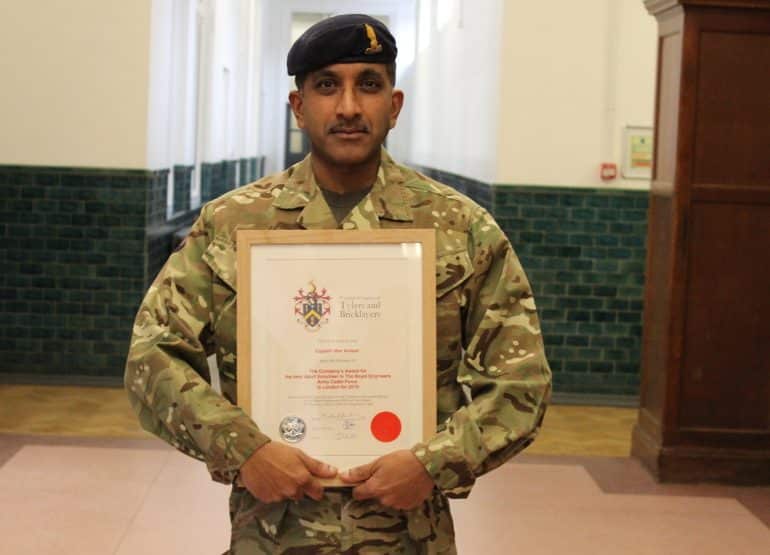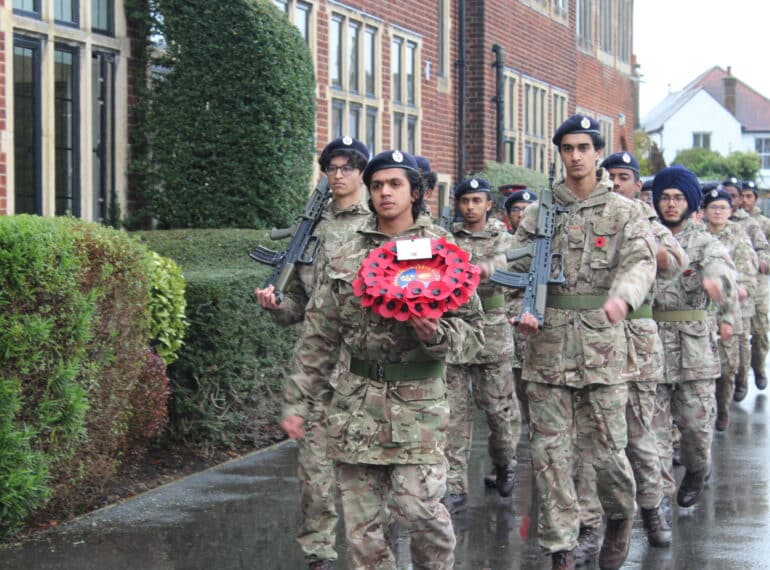
The Combined Cadet Force remembered QE’s own war dead in an act of remembrance at the School, before then playing their part in Sunday’s commemorations in High Barnet.
 One hundred and thirteen old boys of the School died in the First and Second World Wars, while others have been injured and killed in conflicts since.
One hundred and thirteen old boys of the School died in the First and Second World Wars, while others have been injured and killed in conflicts since.
Headmaster Neil Enright said: “On this important day, we remember all those lives lost in conflict, reflecting upon the sacrifices they and others made to secure our freedoms and security.
“We honour the Elizabethans killed in the two world wars, and think, too, of all those affected by conflict around the world.”
On Friday, the School day closest to Armistice Day this year, the whole School paused for a two-minute silence at 11 o’clock.
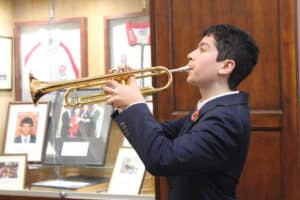 The act of remembrance was led by the School’s CCF. The boys marched to the School’s World War I memorial in the Crush Hall before laying a wreath, demonstrating funeral drill they had learned for the occasion.
The act of remembrance was led by the School’s CCF. The boys marched to the School’s World War I memorial in the Crush Hall before laying a wreath, demonstrating funeral drill they had learned for the occasion.
They were overseen by Staff Sergeant Rhys Peto, the CCF’s School Staff Instructor, who is a member of QE’s Facilities Team.
There was a reading from Laurence Binyon’s poem, For the Fallen, from which the Ode of Remembrance is drawn. The Last Post was played by Joel Swedensky, of Year 12, on the trumpet.
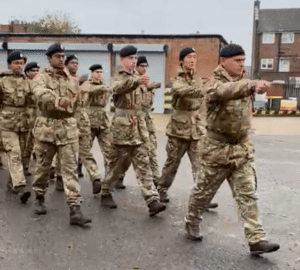 On Remembrance Sunday, 24 cadets turned out, joining High Barnet’s Remembrance Sunday parade, marching from the Army Reserve Centre in St Albans Road down the High Street to St John the Baptist Church, where all attended the church service. Wreath-laying at the war memorial there was carried out by Shubh Rathod and Chinthn Santhalingam, both of Year 13.
On Remembrance Sunday, 24 cadets turned out, joining High Barnet’s Remembrance Sunday parade, marching from the Army Reserve Centre in St Albans Road down the High Street to St John the Baptist Church, where all attended the church service. Wreath-laying at the war memorial there was carried out by Shubh Rathod and Chinthn Santhalingam, both of Year 13.
The School has recently fielded a number of enquiries from the families of Old Elizabethans killed in the two world wars and has been able to use QE Collections to provide them variously with images and information about their relatives from the digital archives.
Among the thousands of artefacts in QE Collections is the speech made by Headmaster E H Jenkins (1930–1961) in 1948 at the dedication service for the School’s World War II memorial. Of the 65 who died in that conflict, 52 had been his own pupils, and, he told the congregation, he remembered them all.
“Their graves are worldwide. In the Far East, in Burmese jungles, on the Western Desert, in the waters that wash around Crete, among the Guards on the Tunisian frontier, in Salerno’s bay, beneath the flak of Berlin, in our own seas… in our own dear homeland, on Normandy beaches, at the crossings of the Rhine – to all of these they have borne, and left to eternity, a part of our Elizabethan heritage. They are gone from us.
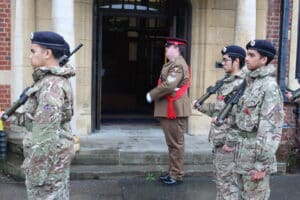 They will not grow old, as we that are left grow old,
They will not grow old, as we that are left grow old,
Age shall not weary them, nor the years condemn,
but we will remember them: we will take up the charge they have left to us, the service of our country and the cause of tolerant freedom which they loved, and for which they died. God helping us, we can do no other. And to masters and boys of this school, as they pass it upon their daily vocations, this bronze, which is now to be dedicated and unveiled, shall be at once a reminder and an inspiration,” Mr Jenkins concluded.

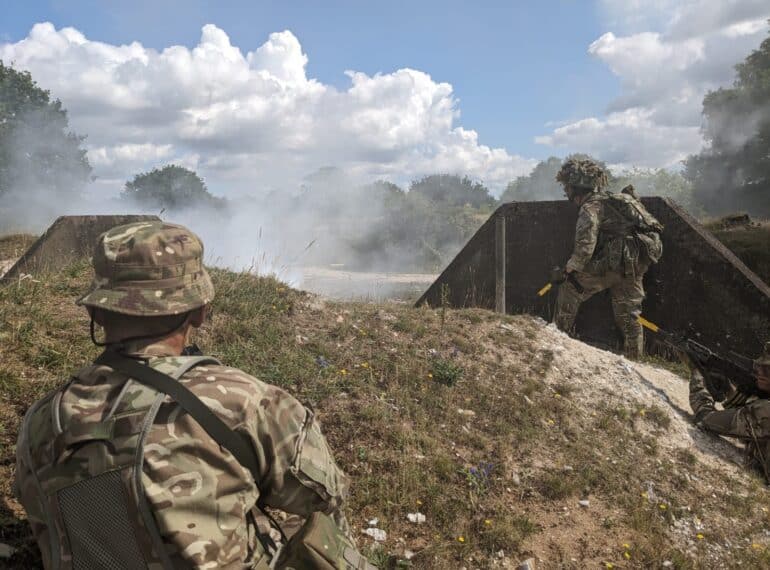
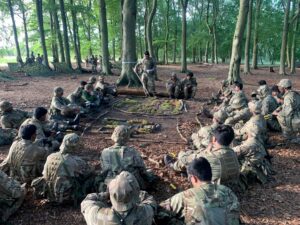 The five-day summer camp at the Barnham Training Area close to the border of Suffolk and Norfolk featured a wide variety of activities, from attacks on ‘enemy’ cadets to weapon-cleaning and administration.
The five-day summer camp at the Barnham Training Area close to the border of Suffolk and Norfolk featured a wide variety of activities, from attacks on ‘enemy’ cadets to weapon-cleaning and administration.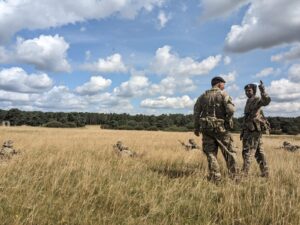 The first two days consisted of further development of section and platoon-level tactics for those cadets who had already had training, together with a ‘recruit cadre’ for those who had not had field craft and tactics training. This brought the latter group up to speed for the 24-hour ‘tactical phase’ that began one night and continued through to the following evening.
The first two days consisted of further development of section and platoon-level tactics for those cadets who had already had training, together with a ‘recruit cadre’ for those who had not had field craft and tactics training. This brought the latter group up to speed for the 24-hour ‘tactical phase’ that began one night and continued through to the following evening.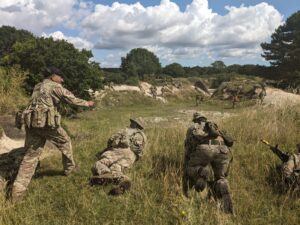 All the platoons then conducted ambushes on enemy patrols to complete the exercise.
All the platoons then conducted ambushes on enemy patrols to complete the exercise.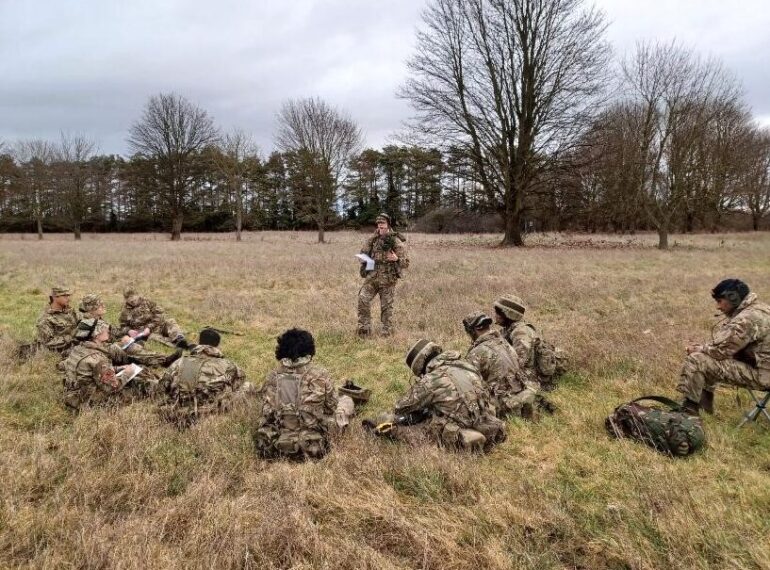
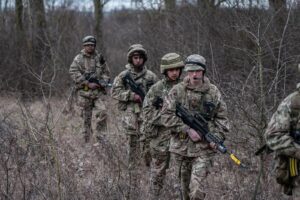 The School is planning a series of exercises so that QE’s Combined Cadet Force can try their hand against the local ACF.
The School is planning a series of exercises so that QE’s Combined Cadet Force can try their hand against the local ACF.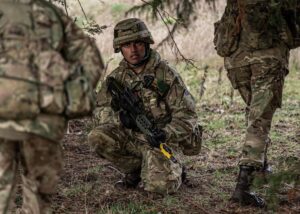 The half-term camp involving ten Sixth Form CCF cadets took place at the Cadet Training Centre Bassingbourn Barracks, Royston, north Hertfordshire.
The half-term camp involving ten Sixth Form CCF cadets took place at the Cadet Training Centre Bassingbourn Barracks, Royston, north Hertfordshire.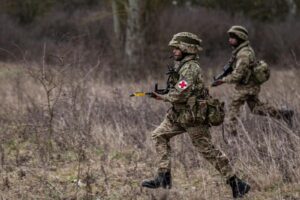 It is essentially a screen that plays out like a video game, yet allows users to try real weapons with the correct action, recoil, and so on. The trainer reacts to the user’s decisions and execution, thus demonstrating the impact of his actions.
It is essentially a screen that plays out like a video game, yet allows users to try real weapons with the correct action, recoil, and so on. The trainer reacts to the user’s decisions and execution, thus demonstrating the impact of his actions.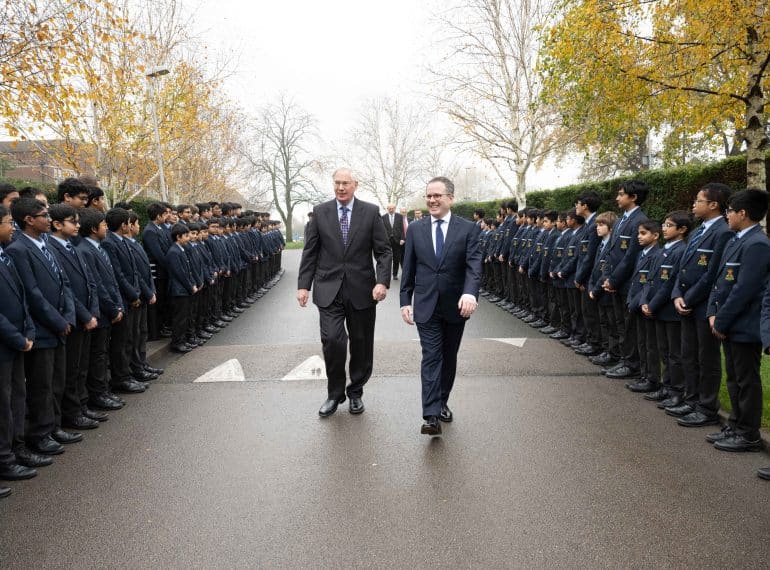
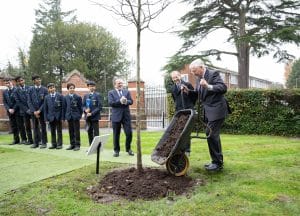 Members of the School’s Combined Cadet Force flanked the main entrance and the senior rugby team provided a sporting backdrop as the Duke arrived for his visit, during which he marked the anniversary by planting an oak tree and by presenting a specially embroidered banner to Headmaster Neil Enright.
Members of the School’s Combined Cadet Force flanked the main entrance and the senior rugby team provided a sporting backdrop as the Duke arrived for his visit, during which he marked the anniversary by planting an oak tree and by presenting a specially embroidered banner to Headmaster Neil Enright. Following the visit, Mr Enright said: “It was a tremendous honour and my great pleasure to welcome HRH The Duke of Gloucester today. With the anniversary fast approaching, there was much to show him, including the School’s original 1573 Charter signed by Elizabeth I, our Ties through Time installation of 232 School photographs from the 1880s until comparatively modern times, and, to bring things right up to date, the robots and our new Music building, opened in May.
Following the visit, Mr Enright said: “It was a tremendous honour and my great pleasure to welcome HRH The Duke of Gloucester today. With the anniversary fast approaching, there was much to show him, including the School’s original 1573 Charter signed by Elizabeth I, our Ties through Time installation of 232 School photographs from the 1880s until comparatively modern times, and, to bring things right up to date, the robots and our new Music building, opened in May.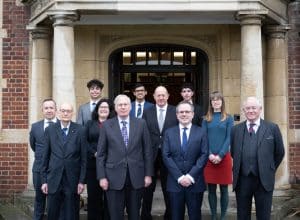 He was then introduced to:
He was then introduced to: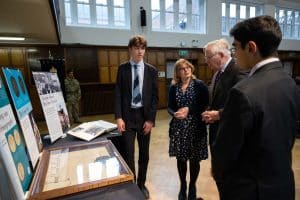 Gabriel Gulliford.
Gabriel Gulliford.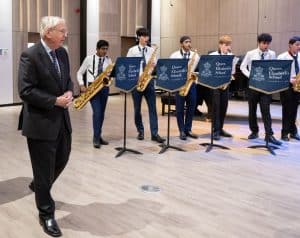 After visiting the Ties through Time photographic installation and enjoying the robotics in the School’s Conference Centre, the royal party headed to the new Music building to watch rehearsals for this Thursday’s Winter Concert under the watchful eye of Director of Music Ruth Partington.
After visiting the Ties through Time photographic installation and enjoying the robotics in the School’s Conference Centre, the royal party headed to the new Music building to watch rehearsals for this Thursday’s Winter Concert under the watchful eye of Director of Music Ruth Partington.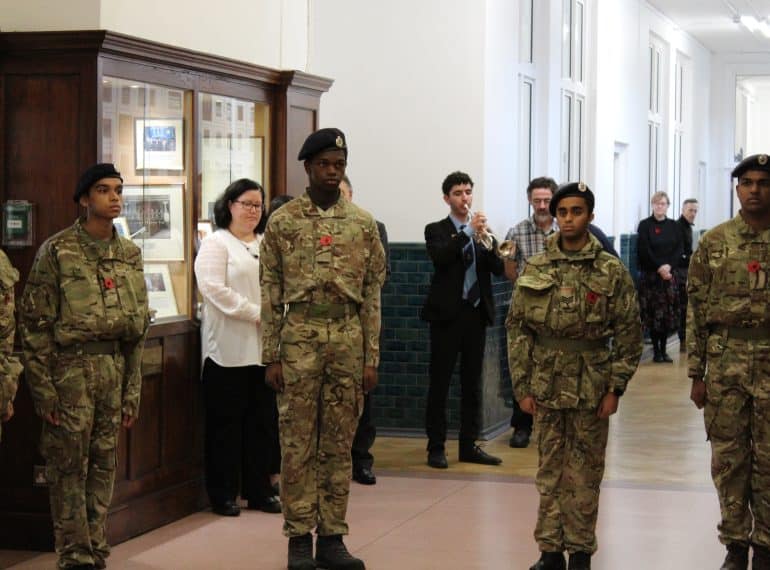
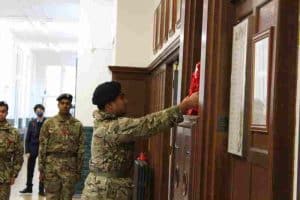 Through the two events, today’s Elizabethans remembered the 113 old boys who lost their lives in the 20th century’s two world wars and those who have been injured or died in wars since.
Through the two events, today’s Elizabethans remembered the 113 old boys who lost their lives in the 20th century’s two world wars and those who have been injured or died in wars since.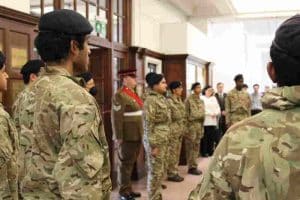 QE’s traditional 11.00am act of remembrance took place at the School’s World War I memorial in the Crush Hall. It was led by representatives of the School’s Combined Cadet Force, who were joined by Colour Sergeant Rhys Peto, the CCF’s School Staff Instructor, who is a member of QE’s Facilities Team.
QE’s traditional 11.00am act of remembrance took place at the School’s World War I memorial in the Crush Hall. It was led by representatives of the School’s Combined Cadet Force, who were joined by Colour Sergeant Rhys Peto, the CCF’s School Staff Instructor, who is a member of QE’s Facilities Team.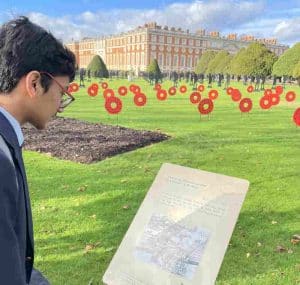 Two days later, 36 of the School’s cadets and CCF staff representatives participated in High Barnet’s Remembrance Sunday events. After assembling at Barnet Army Reserve centre in St Albans Road, they paraded down Barnet High Street and joined the church service at St John the Baptist Church, where there was the playing of the Last Post and a wreath-laying ceremony. Events concluded with a march-past, where Martin Russell, the Representative Deputy Lieutenant for the London Borough of Barnet (and the parent of an Old Elizabethan) took the salute.
Two days later, 36 of the School’s cadets and CCF staff representatives participated in High Barnet’s Remembrance Sunday events. After assembling at Barnet Army Reserve centre in St Albans Road, they paraded down Barnet High Street and joined the church service at St John the Baptist Church, where there was the playing of the Last Post and a wreath-laying ceremony. Events concluded with a march-past, where Martin Russell, the Representative Deputy Lieutenant for the London Borough of Barnet (and the parent of an Old Elizabethan) took the salute.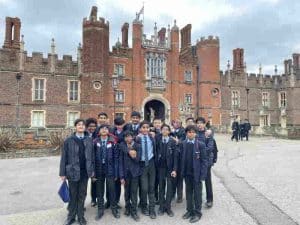 Helen Edmunds, Head of History & Politics, said: “Hampton Court provides excellent contemporary sources, including a display of diaries and letters written by the soldiers who were there just over a century ago. This links in well in with the work our pupils will do next year when they enter Year 9 on the role and importance of Empire troops during World War I and World War II.
Helen Edmunds, Head of History & Politics, said: “Hampton Court provides excellent contemporary sources, including a display of diaries and letters written by the soldiers who were there just over a century ago. This links in well in with the work our pupils will do next year when they enter Year 9 on the role and importance of Empire troops during World War I and World War II.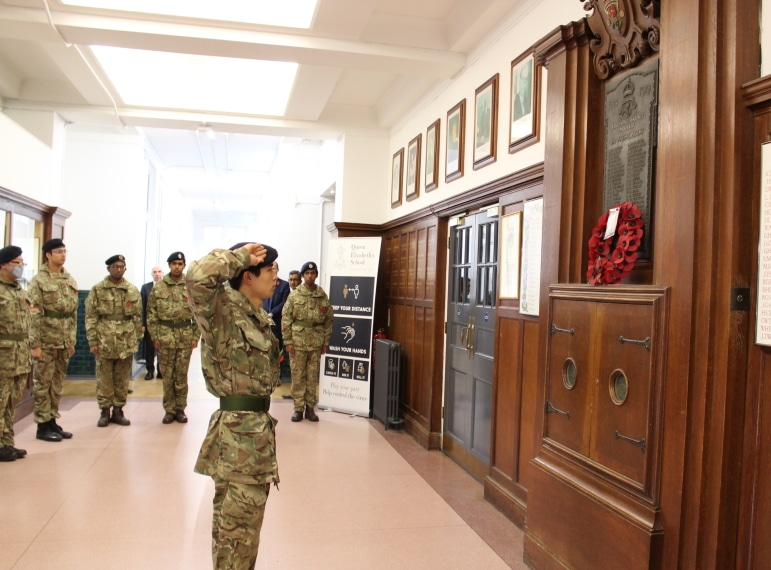
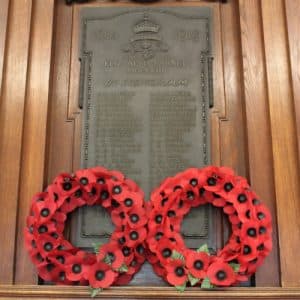 The cadets paraded into the Crush Hall, the area just outside the Main Hall, at 10.55am to take up their positions ahead of the 11am silence. They were led by Cadet Staff Sergeant Lucas Lu, of Year 13, who gave the commands and laid the wreath at the World War I memorial on behalf of the CCF and School.
The cadets paraded into the Crush Hall, the area just outside the Main Hall, at 10.55am to take up their positions ahead of the 11am silence. They were led by Cadet Staff Sergeant Lucas Lu, of Year 13, who gave the commands and laid the wreath at the World War I memorial on behalf of the CCF and School.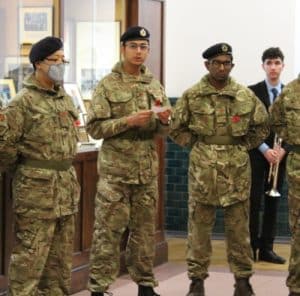 “In saluting th0se Elizabethans from generations past who gave their lives for a cause greater than themselves, we firstly pay tribute to their sacrifice and secondly encourage our current pupils to reflect on the School’s long and continuing tradition of service.”
“In saluting th0se Elizabethans from generations past who gave their lives for a cause greater than themselves, we firstly pay tribute to their sacrifice and secondly encourage our current pupils to reflect on the School’s long and continuing tradition of service.”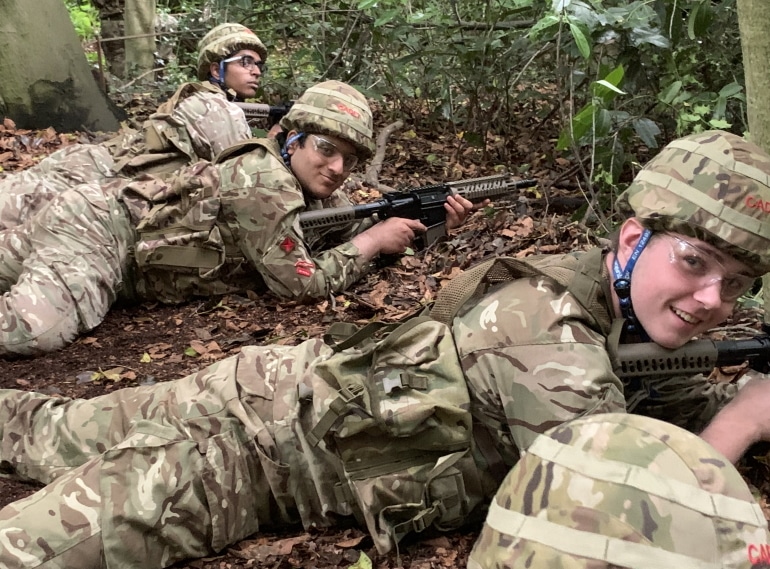
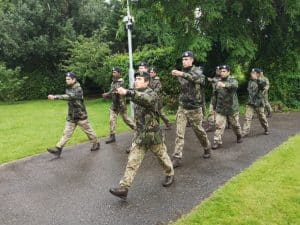 Cadets from Year 10 to Year 12 travelled to the camp in Hampshire and battled it out in an inter-section competition designed to test their abilities in activities ranging from archery to drill.
Cadets from Year 10 to Year 12 travelled to the camp in Hampshire and battled it out in an inter-section competition designed to test their abilities in activities ranging from archery to drill.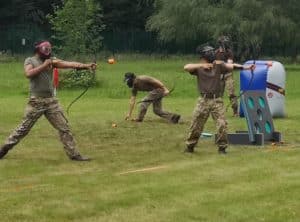 These included the strictly regimented Queens Guard Drill and the “rather more chaotic archery tag”, where the boys enjoyed the chance to fire rubber arrows at each other – “with varying success”, as Major Armon reports.
These included the strictly regimented Queens Guard Drill and the “rather more chaotic archery tag”, where the boys enjoyed the chance to fire rubber arrows at each other – “with varying success”, as Major Armon reports.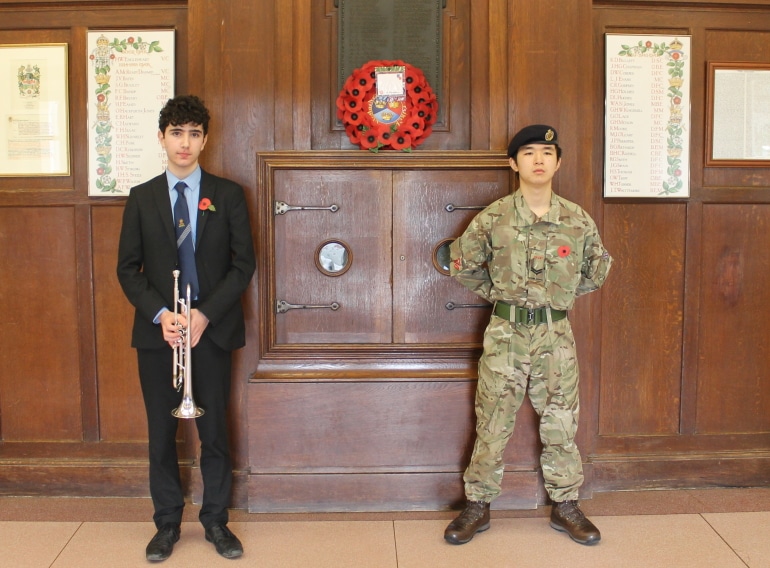
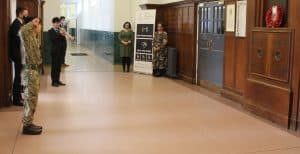 When boys fell silent at 11am on 11th November it was in their classrooms, while a smaller-than-usual wreath-laying ceremony took place at the World War I Memorial outside the Main School Hall.
When boys fell silent at 11am on 11th November it was in their classrooms, while a smaller-than-usual wreath-laying ceremony took place at the World War I Memorial outside the Main School Hall.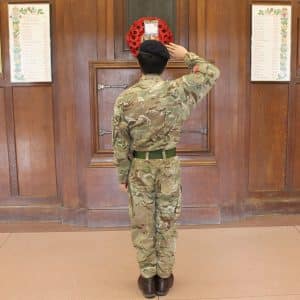 The bugler who played the Last Post and Reveille at the School ceremony was Theo Mama-Kahn, of Year 11, who is studying GCSE Music. The cadet laying a wreath was Lucas Lu, of Year 12.
The bugler who played the Last Post and Reveille at the School ceremony was Theo Mama-Kahn, of Year 11, who is studying GCSE Music. The cadet laying a wreath was Lucas Lu, of Year 12.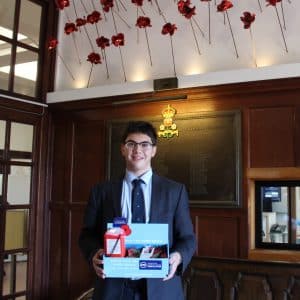 To ensure boys of all ages understood the significance of the occasion, a PowerPoint presentation detailing the history of the day was sent to form tutors to spark discussion among the pupils. It explained the importance of poppies – the first flowers to bloom on the World War I battlefields of Belgium and France – and included the famous poem they inspired, John McCrae’s In Flanders fields. Boys were also invited to watch a
To ensure boys of all ages understood the significance of the occasion, a PowerPoint presentation detailing the history of the day was sent to form tutors to spark discussion among the pupils. It explained the importance of poppies – the first flowers to bloom on the World War I battlefields of Belgium and France – and included the famous poem they inspired, John McCrae’s In Flanders fields. Boys were also invited to watch a 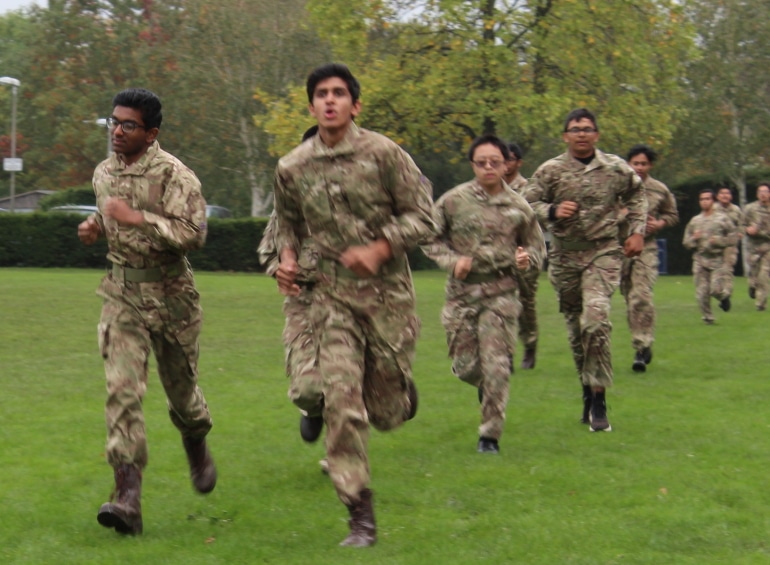
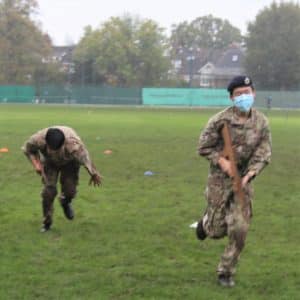 The cadets will be battling it out for the rest of the term in a series of activities focused on refreshing their basic skills in field craft, weapon-handling and drill.
The cadets will be battling it out for the rest of the term in a series of activities focused on refreshing their basic skills in field craft, weapon-handling and drill.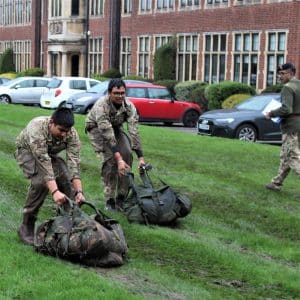 The first two weeks are focusing on Battle Field PT [physical training], including a ‘basic fitness test run’, ‘casualty drag’, ‘fire team fire-and-manoeuvre stand’ and a ‘jerry can carry stand’. This is being run by 2nd Lieutenant Richard Scally (Head of Cricket & Head of Aquatics), assisted by Physics teacher Jonathan Leigh.
The first two weeks are focusing on Battle Field PT [physical training], including a ‘basic fitness test run’, ‘casualty drag’, ‘fire team fire-and-manoeuvre stand’ and a ‘jerry can carry stand’. This is being run by 2nd Lieutenant Richard Scally (Head of Cricket & Head of Aquatics), assisted by Physics teacher Jonathan Leigh.